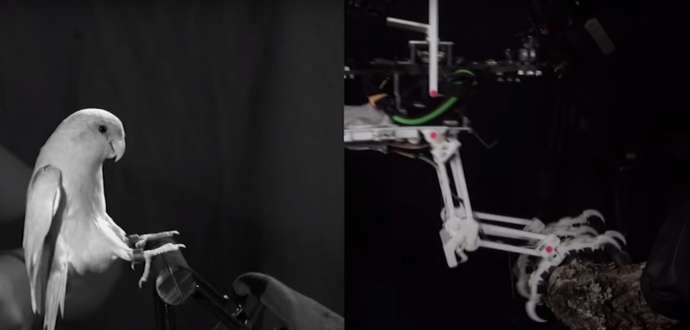Časoris is an online newspaper aimed at children. Each week we’ll take an article and post it here as a Slovene-English dual text.
Robot, ki so ga navdahnile ptice
A robot inspired by birds
Written by Sandra Hanžič, translated by JL Flanner & G Translate
S čim navdušujejo ptice?
Why are we fascinated by birds?
Ptice lahko letijo; ta brezmejna svoboda je človeštvo navdihovala vso zgodovino.
Birds can fly; this boundless freedom has inspired humanity throughout history.
A pomembno je tudi, da pristanejo na skoraj vsaki površini.
But it is also important that they can land on almost any surface.
Ta lastnost je dolgo vznemirjala znanstvenike.
This characteristic has long intrigued scientists.
Ekipa inženirjev univerze Stanford je sedaj ustvarila robota, ki lahko sedi, prenaša in lovi predmete tudi v zraku. Ujame lahko celo teniško žogico!
A team of Stanford University engineers has now created a robot that can sit, carry and hunt objects even in the air. It can even catch a tennis ball!
Navdih za njegova stopala in noge so našli pri sokolu selcu.
Inspiration for his feet and legs was found in the falcon.
Presenetilo nas je, da ptice pri pristajanju v zraku izvajajo enake prijeme ne glede na površino, na katero se spuščajo. Svojim nogam pustijo, da se prilagodijo raznolikosti in zahtevnosti površine. - William Roderick
We were surprised that the birds perform the same grips when landing in the air, regardless of the surface on which they land. They allow their feet to adapt to the diversity and complexity of the surface. – William Roderick
Vsaka robotova noga ima dva motorja; en skrbi za premikanje naprej in nazaj, drugi pa uravnava oprijem površine.
Each robot leg has two motors; one takes care of moving back and forth and the other regulates the grip of the surface.
Poseben oprijemalni mehanizem na koncu noge absorbira energijo pristanka in jo pretvori v silo oprijema. Sproži, razpre in zapre se v 20 milisekundah.
A special gripping mechanism at the end of the leg absorbs the landing energy and converts it into a gripping force. Triggers, unfolds and closes in 20 milliseconds.
Robot lahko tako pristane na katerikoli površini – na suhi ali na mokri, na gladki ali na grobi.
The robot can land on any surface - dry or wet, smooth or rough.
Pri čem ta znanstveni preboj lahko pomaga?
What can this scientific breakthrough help with?
Znanstveniki menijo, da bi taki leteči roboti lahko sodelovali pri iskanju ter reševanju ali pri spremljanju požarov v naravi.
Scientists believe that such flying robots could be involved in search and rescue, or monitoring wildfires.
Dosedaj so morali v takih primerih lebedeti, odslej pa bi lahko marsikje tudi pristali in tako varčevali z energijo.
To date, they have had to hover in such cases, but from now on they could land in many places and thus save energy.
Ekologi pa bi z njimi lažje zbirati podatke, denimo v nedostopnih gozdovih.
It would also be easier for ecologists to collect data with them, for example in inaccessible forests.
Roboti, ki so jih navdahnile ptice, so združljivi tudi z drugimi tehnologijami, ne samo z droni.
Bird-inspired robots are also compatible with other technologies, not just drones.
»Želimo, da bi lahko pristali kjer koli – to je tisto, kar to tehnologijo naredi vznemirljivo,« pravi eden od sodelujočih strokovnjakov David Lentink.
“We want to be able to land anywhere - that’s what makes this technology exciting,” says one of the participating experts, David Lentink.
Read more stories and improve your Slovene at Časoris, while all our dual texts can be found here.






